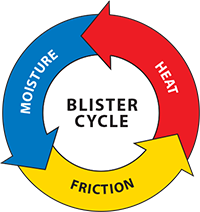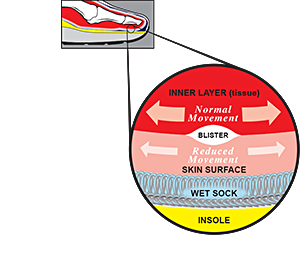The Blister Problem
Foot Blisters are the Most Common Running Injury
Blisters on the feet are the most common injury and seem inevitable when running long distances. One study in the Journal of Sports Medicine 2004;38:498-501 reported that up to 39% of marathon runners experienced foot blisters while running marathons. Runners can’t physically run enough training miles to condition their feet not to get blisters for long distance races of 100+ miles especially if the conditions of the course are bad. In the past, the most successful runners learned to run with the pain of having blisters, calling them a “badge of courage.” Until now, there has been limited success in actually preventing blisters. Runners have tried everything to prevent blisters including Vaseline®, skin lubricants, powders and tape. These may help for a short period of time, but are not effective over long distances. Oily lubricants can be detrimental as they prevent socks from effectively removing moisture from the skin.
Foot Blisters Can Cause Further Injury
A study to determine the association of blisters with subsequent injuries was conducted by RS Bush, SK Brodine & RA Shaffer with 2,130 male US Marine Corps recruits participating in initial physical training at the Marine Corps Recruit Depot in San Diego, California. The study found that recruits with blisters were 50% more likely to experience an additional training-related injury.
Blister Cycle
 Foot blisters are most common on the toes, heel, and ball of the foot. Blisters caused by socks usually occur when socks do not fit, their seams irritate the skin, and/or the socks become wet. Wet socks soften and weaken the skin, making feet vulnerable to blisters. Heat, moisture and friction work together to cause blisters, each contributing to the severity of the others creating a Blister Cycle.
Foot blisters are most common on the toes, heel, and ball of the foot. Blisters caused by socks usually occur when socks do not fit, their seams irritate the skin, and/or the socks become wet. Wet socks soften and weaken the skin, making feet vulnerable to blisters. Heat, moisture and friction work together to cause blisters, each contributing to the severity of the others creating a Blister Cycle.
HEAT
Excess heat normally radiates away from bare feet, but wearing shoes traps heat, elevating the temperature of the skin. Heat generated by physical activity can further raise the temperature inside shoes 20 degrees or more.
MOISTURE

With higher than normal skin temperature, the body produces sweat to cool the skin by evaporation. Wearing shoes prevents evaporative cooling from effectively taking place, leaving socks and feet wet.
FRICTION
Moisture significantly increases friction between socks and skin. Higher friction limits skin surface movement, but still allows inner tissue movement. This shearing effect physically separates the two layers, creating a void. This void fills with fluid forming a blister.




